Predicting the Position of a Rotating System

In order to provide a cohesive and detailed model of the motion of a rotating object (including Systems with Zero Torque and Systems with Nonzero Torque) it is necessary to predict the position of a rotating system.
The Main Idea
The position of a rotating system can be predicted by predicting the angle over which the object will rotate through out time. Basically, the key to finding out how much a rotating object has moved (over a specific time interval) is the angle through which it moves.
A Mathematical Model
Given that the system in question is indeed rotating, the update form of The Angular Momentum Principle is always applied about the the center of mass in our calculations.
The update form of the Angular Momentum Principle is as follows: [math]\displaystyle{ \vec{L}_{rot,f}=\vec{L}_{rot,i}+\vec{\tau}_{net}\Delta t }[/math] where [math]\displaystyle{ {L} }[/math] is rotational angular momentum and [math]\displaystyle{ \tau }[/math] is net torque from the surroundings.
In basic situations, the update form of the Angular Momentum Principle can further be simplified to account for The Moments of Inertia, [math]\displaystyle{ I }[/math], and the Angular Velocity, [math]\displaystyle{ \omega }[/math] of the rotating system. This simplification of the update form of the Angular Momentum Principle yields the following mathematical equation: [math]\displaystyle{ I\omega _{f}=I\omega _{i}+RF\Delta t }[/math] where net torque, [math]\displaystyle{ \vec{\tau}_{net} }[/math] is simplified to the product of all the forces acting on the system and the locations to which these forces are applied, [math]\displaystyle{ RF }[/math].
As mentioned before, the key to solving these types of problems is figuring out the angle, [math]\theta[/math], which the object rotates through. Given that the angle will always change at an instantaneous rate of [math]\omega=d\theta / dt[/math], the change in the angle [math]\theta[/math] is: [math]\Delta \theta=\omega_{avg} \Delta t[/math].
We will limit the complexity of this topic to situations where the angular speed [math]\omega[/math] changes at a constant rate [math]RF / I[/math]. Therefore, the average speed is said to be: [math]\omega_{avg}=\frac{\omega_{i} + \omega_{f} }{2}[/math]
On the other hand, if one utilizes the basic linear Kinematic Equations of [math]x = x_{o} + v_{o} * t + 1/2 * a * t^2[/math], [math]v^2 = v_{o}^2 + a * t[/math], and [math]v = v_{o} + 2 * a * \Delta d[/math], we can adapt these equations for rotational systems.
The following is the symbol conversion between Linear and Angular Systems.
| Linear | Angular | Equation |
|---|---|---|
| [math]x[/math] | [math]\theta[/math] | [math]\theta = \frac{x}{r}[/math] |
| [math]v[/math] | [math]\omega[/math] | [math]\omega = \frac{v}{r}[/math] |
| [math]a[/math] | [math]\alpha[/math] | [math]\alpha = \frac{a}{r}[/math] |
| [math]f[/math] | [math]\tau[/math] | [math]\tau = f \times r[/math] |
In other words, the angular systems versions of kinematic equations are:
[math]\theta = \theta_{o} + \omega_{o} * t + \frac{1}{2} * \alpha * t^2[/math]
[math]\omega = \omega_{o} + \alpha * t[/math]
[math]\omega^2 = \omega_{o}^2 + 2 * \alpha * \Delta \theta[/math]
Simply plug in known values, in radians, and solve for the unknown. Just like the linear kinematic equations.
A Computational Model
The position of a rotating system can be predicted using the following vPython code below. Try out the code here with different values!. Take note that the default values in the code computationally calculate the answers to this physics problem.
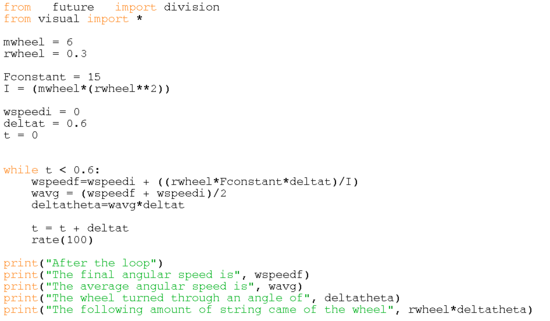
Examples
Simple
A wheel of radius [math]\displaystyle{ R }[/math] and a moment of inertia [math]\displaystyle{ I }[/math] is mounted on a low-friction axle. A string is wrapped around the edge, and you pull on it with a force [math]\displaystyle{ F }[/math], At a certain time the angular speed is [math]\displaystyle{ \omega_{i} }[/math].
(a) After a time interval [math]\displaystyle{ \Delta t }[/math], what is the angular speed [math]\displaystyle{ \omega_{f} }[/math]?
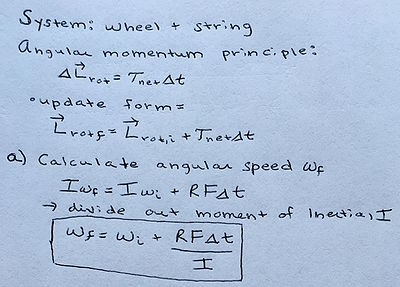
(b) How far did your hand move during this time interval?

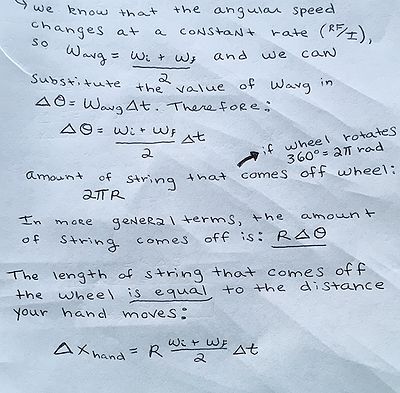
Middling
A uniform-density wheel of mass 6 kg and radius 0.3 m rotates on a low-friction axle. Starting from rest, a string wrapped around the edge exerts a constant force of 15 N for 0.6 s.
(a) What is the final angular speed?
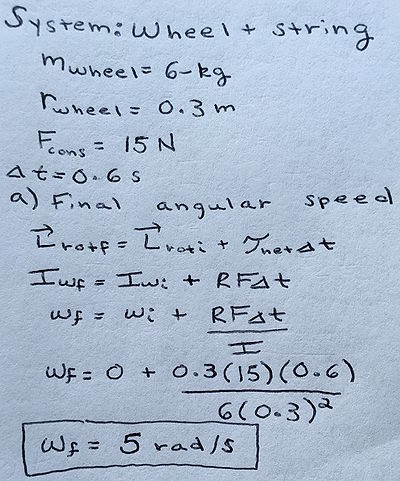
(b) What is the average angular speed?
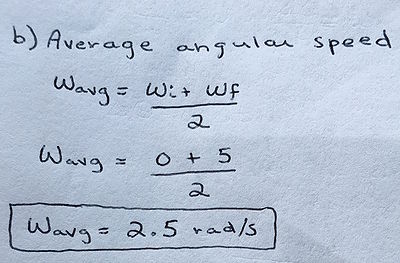
(c) Through how big an angle did the wheel turn?

(d) How much string came off the wheel?
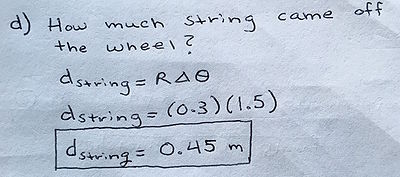
Connectedness
Industrial Application


In the theme and amusement park industry (e.g. Six Flags and Disney World), the aforementioned method of predicting the position of a rotating system can be applied to determine how far a certain rider has moved on either Mickey's Fun Wheel or Colossus. This prediction of a rider's position after a certain amount of time could be applied by economists to determine the ideal speed and time interval to run their respective ferris wheels to yield an optimal economic profit with respect to the cost of admission tickets.
Scientific Application
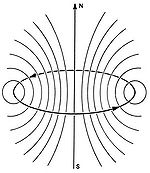

Predicting the position of a rotating system can also pioneer revelations in scientific research fields (esp. biochemistry and chemistry). Given that the position of an electron in relation to the nucleus of a hydrogen atom can be predicted based upon the angular momentum of the electron, this technique can be applied to determining the magnetism exhibited by the electron with respect to some defined axis. Therefore, the relationship between the position of an electron at a certain time (at some distance from a defined axis) could be related to the electric current produced by a magnetic field at that same time.
History
The key mathematical equation to predicting the position of a rotating system, the update form of the Angular Momentum Principle, has historical roots in the Laws of Motion of Sir Isaac Newton. The conservation of angular momentum was further described and put into terms by Johannes Kepler.
See also
The Angular Momentum Principle
Further reading
Judd, Brian R. Angular Momentum Theory for Diatomic Molecules. Academic Press, 1975. Print.
External links
Angular Momentum - Science Theater Video
A Guide to the Angular Momentum Principle
References
Chabay, Ruth W., and Bruce A. Sherwood. Matter & Interactions. Hoboken, NJ: Wiley, 2015. 443-45. Print.